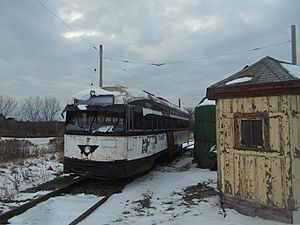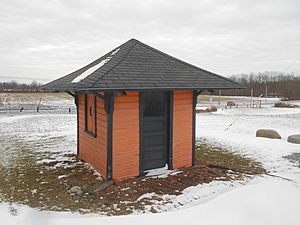New York Museum of Transportation facts for kids

The former Newark City Subway streetcar used by New Jersey Transit on the museum property in January 2015.
|
|
| Established | 1973 |
|---|---|
| Location | Rush, New York |
| Type | Railroad museum |
The New York Museum of Transportation (NYMT) is a special place in Rush, New York, near Rochester. It started in 1975 and is run by volunteers. This museum is connected to the Rochester & Genesee Valley Railroad Museum by a two-mile train track.
This special track lets both museums offer fun train rides. You can see their collections of old trains and trolleys. The NYMT is the only place in New York State where you can ride an electric trolley. It's different from the Trolley Museum of New York in Kingston.
Contents
How the Museum Started
The last streetcars stopped running in Rochester in 1941. The Rochester Subway kept going until 1956. Some old streetcars were given to other museums, but they often didn't have a permanent home.
The idea for the New York Museum of Transportation came from the Magee Transportation Museum in Pennsylvania. This private museum had many old cars and trolleys. Sadly, a big flood in 1972 damaged the museum's tracks and trolleys. After the owner, Harry Magee, passed away, his collection was sold.
Harry Magee had hoped that the Rochester streetcars in his collection would return to New York. Henry Hamlin, who was planning a new community called Riverton, wanted to bring them back. He imagined a small trolley museum as part of a new light rail line.
In 1973, the museum got its first old trolley, car 107, from the Magee collection. They also got car 157 and parts to build overhead wires for trolleys. These cars were moved into an old dairy barn in West Henrietta. Other historic cars, like a sand car and a horse car, also came to the barn. In 1975, the New York Museum of Transportation officially began.
By 1975, the city of Rochester was no longer using the western part of the old Rochester Subway tracks. Volunteers from NYMT were allowed to take track materials from there. They used these materials to build their own rail line around the museum. More historic vehicles were added, and a gift shop and exhibit hall were set up in the old barn.
Building the Trolley Line
In 1976, the museum started building its demonstration railroad. By 1979, it was almost three-quarters of a mile long. In 1980, NYMT began offering rides on small gas-powered vehicles called "track cars." These were once used by railway workers.
Around the same time, the nearby Rochester and Genesee Valley Railroad Museum also started building its own track. In 1993, the two museums' tracks connected. This was a big moment, celebrated with a "golden spike" ceremony. Now, visitors could ride track cars all the way between the two museums.
Bringing Trolleys to Life
In 1996, the museum got the body of an old trolley, no. 409, from a restaurant. It's now a popular spot for birthday parties. Another trolley body, no. 437, was acquired in 1997. It is now being evaluated for possible restoration.
The museum also got two working steel trolleys, cars 161 and 168, in 1996. These trolleys were built in the 1920s and used in Philadelphia. Even though they weren't from Rochester, they helped the museum offer regular trolley rides to visitors.
In 2002, proper wheels were found for Car 157, which was an important step for its restoration.
Even with working trolleys, the NYMT needed a place to run them. Throughout the late 1990s, volunteers worked hard to set up poles and string overhead wires for the trolleys. In 2001, the first quarter-mile of electric track was ready. This meant the Rochester area had its first public trolley rides since 1956!
By 2006, the electric line was extended almost a full mile to a new "Midway station." A special power station was built to provide electricity for the trolleys. Now, regular trolley rides are a big part of the museum experience. Visitors can ride the trolley and then switch to track cars or diesel trains to continue to the Rochester & Genesee Valley Railroad Museum.
In 2014, NYMT acquired former NJ Transit trolley no. 7. This trolley ran in the Newark City Subway until 2001. It's an important example of modern trolley design. Volunteers are now evaluating it for future restoration.
A big goal for the future is to fully restore Rochester Subway car 60. The museum hopes to run it on the line. A fundraising campaign for car 60 began in June 2014.
Visiting the Museum
The museum is open every Sunday from mid-May to the end of October. It's open from 11:00 a.m. to 4:00 p.m. Trolley rides are offered almost every day the museum is open, usually using car 161 or 168. The trolleys travel from NYMT to Midway station.
Some weekends in December, the museum offers special Christmas-themed train rides on the trolleys. Car 161 is often used for these rides because it has a recently fixed heating system.
Museum Collection
Here are some of the cool vehicles you can see at the museum:
- Rochester Transit Corporation 0243: This car was built in 1891 and later became a sand car. It's currently on display, being put back together.
- Batavia Traction Company 33: Built in 1911, this car was used by the Batavia Traction Co. It's now on display.
- New York State Railways Rochester Lines 437: Built in 1904, this car is currently stored in the carbarn.
- New York State Railways Rochester Lines 1402: Built in 1904, this car is currently stored.
- Elmira, Corning and Waverly Railway 107: Built in 1911, this car is on display.
- New York State Railways Rochester and Eastern Rapid Railway 157: Built in 1914, this car is on display.
- Philadelphia and Western Railroad 161: Built in 1927, this trolley is used regularly for Sunday operations.
- Philadelphia and Western Railroad 168: Built in 1929, this trolley is kept as a backup car.
- Northern Texas Traction Company 409: Built in 1919, this car body was once in a restaurant. It's now on display and used for parties.
- Hornell Traction Company 34: Built in 1905, this is a snow plow body. It is currently stored.
- Philadelphia Transportation Company C-130: Built in 1923, this is a snow sweeper. It is operational and on display.
- Rochester Transit Corporation L-2: This is a gasoline locomotive used on the Rochester Subway. It is currently stored.
- Genesee and Wyoming Railroad 8: This wooden caboose was built in 1914. It has been restored and is stored.


